Healthcare App Development: How to Build a Helpful Medical App
COVID-19 has driven the rapid adoption of telehealth services. Between February and April 2020, the use of telehealth for office visits and outpatient care increased 78 times over. In 2021, Grand View Research expects the global telemedicine market size to reach US$299 billion.
The pandemic changed how people view telehealth; it offered a necessary balance between needed care services and social distancing. Patients, doctors, and government officials alike are actively seeking digital solutions to make healthcare more flexible. If there’s an opportunity to decrease hospital visits, providers are likely to take it.
Now more than ever there’s a greater chance for new apps to successfully enter the mHealth market. However, remember that quality over quantity is key here. Good healthcare app development focuses on making a genuinely helpful product. Before you begin, explore the market and focus on a specific branch of healthcare. Consult with medical experts and make sure your app’s foundations are rooted in scientific research.
From a development point of view, there’s also a greater need for quality: a high level of security, and the introduction of advanced technologies including voice search, artificial intelligence, and, if necessary, machine learning. There’s a lot to consider, butMadAppGang has extensive experience in the mHealth field, and we can help.
Before we get into the details, let’s take a look at which apps are already out there and which features are in demand.
Healthcare mobile apps: Choosing the right type
First and foremost, you need to define the type of application you want to make and your chosen speciality. Are your target users patients or healthcare workers? Will the app help people with mental health issues or help monitor individuals with chronic diseases? Or is your goal to facilitate the delivery of medications?
The mobile healthcare market is large and diverse, narrowing your focus according to the type of app you’ll create and services you’ll offer is essential.
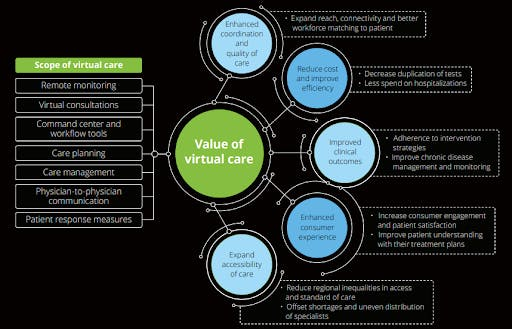
The value of virtual care. Source: Deloiette
Regardless of the service, your solution should be user-centric. Design a healthcare app that is as helpful and clear as possible. Our experience with healthcare and health-adjacent apps tells us that ease-of-use is crucial. For instance, developing SmartRun, from beta-testing and customer feedback we learnt that simple, clear and engaging interfaces matter. Without good UX, users are likely to delete apps within mere hours.
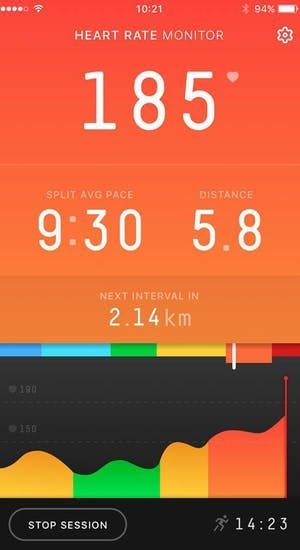
Example of simple and understandable user interface for health-adjacent apps. Source: SmartRun app interface
Let’s get back to business and review some popular ideas for telehealth app development and types of healthcare apps.
Remote patient monitoring
Remote patient monitoring (RPM) systems are software applications that analyse physiological data via smart health wearables, such as glucose trackers. These technologies give greater insight into patients’ conditions and help guide decision-making when it comes to treatment options. In addition, these devices and systems are an affordable solution for healthcare providers. For patients, wearables and RPM systems can offer reassurance.
BioButton is a great example of an RPM system and wearable device that proved its cost-efficiency monitoring Covid-19 symptoms. BioButton is capable of tracking an individual’s temperature and heart and respiratory rates via its patented biosensor technology and advanced analytics.
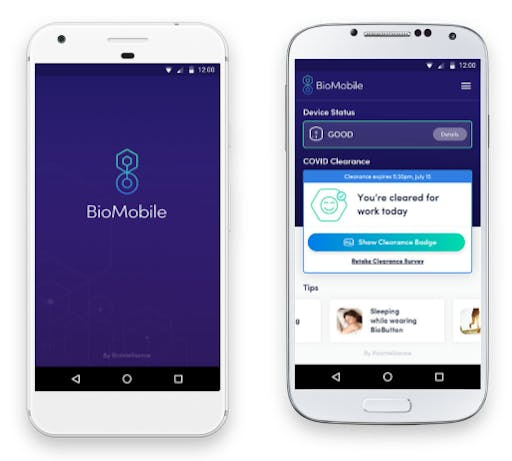
Example of BioButton app interface. Source: Biointellisense
Telemedicine app
Telemedicine apps allow people to get medical advice remotely. Patients and doctors alike benefit from these apps as they reduce waiting times, allow doctors to control their schedules, and make medical care more affordable. Telemedicine apps are likely to become more popular in the next decade due to their convenience.
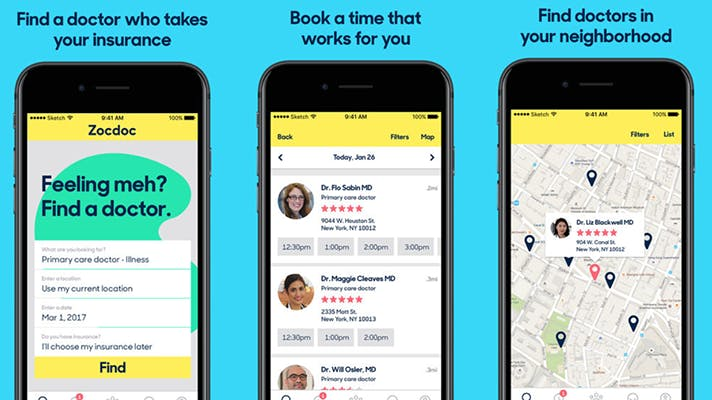
ZocDoc app user interface. Source: Healthcareitnews
Telehealth applications of this type need an audio and visual messaging agent and messenger and storage functionalities for medical records and other health data. Good examples are the Doctor On Demand and ZocDoc apps, which are designed for users to receive medical advice through video chat in addition to booking doctor’s appointments.
Urgent care platforms
Urgent care applications offer quick help for patients who have immediate but not life-threatening medical concerns. If your healthcare app development will focus on providing urgent care, you help patients avoid unnecessary trips to the ER, saving time, money and resources.
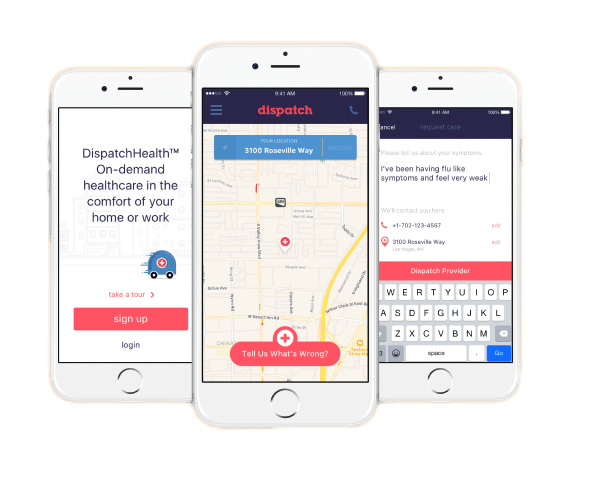
The Dispatch Health app interface example. Source: Dispatch Health
Projects like Ready and Dispatch Health make accessing urgent care at home as easy as ordering food. In addition to video chats with a professional, users can request a callback or schedule an in-person visit. Most apps of this type include maps so patients can specify their locations.
Chronic condition monitoring
Here are some shocking statistics: 50% of Australians live with a chronic condition, and more than 40% of Americans suffer from chronic diseases. As you see, there’s a vast number of people all over the world who could benefit from applications that track their health. Accordingly, apps for chronic illness management will become increasingly popular over time.
Most popular are apps that help people with diabetes, cancer, and kidney and heart disease. The Strive Health platform helps people with kidney issues. By combining advanced technology and high-quality patient care, Strive Health has become a useful tool for improving clinical outcomes and saving money for both patients and hospitals.
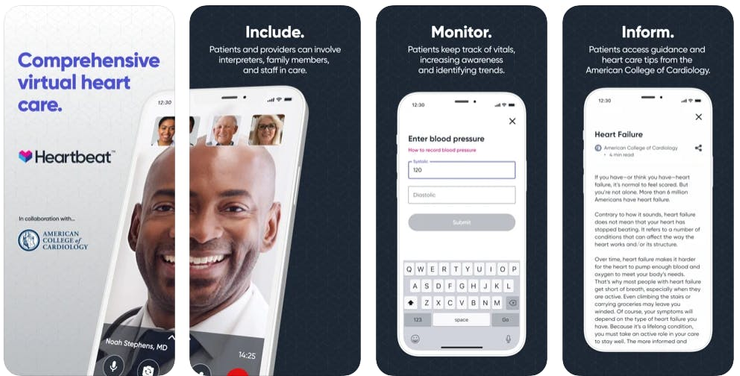
Heartbeat Health app. Source: App Store
Heartbeat Health and Hinge Health are also good examples. Both technologies utilise technologies including RPMs, wearable devices, and provide telemedicine services.
Medicine delivery apps
On-demand medicine delivery apps offer direct to doorstep pharmaceutical deliveries, helping those who need medication but can’t reach a pharmacy. Examples of this type of telehealth app include Tomorrow Health, which offers medical equipment deliveries, and PharmEasy, an app that enables remote prescription orders.
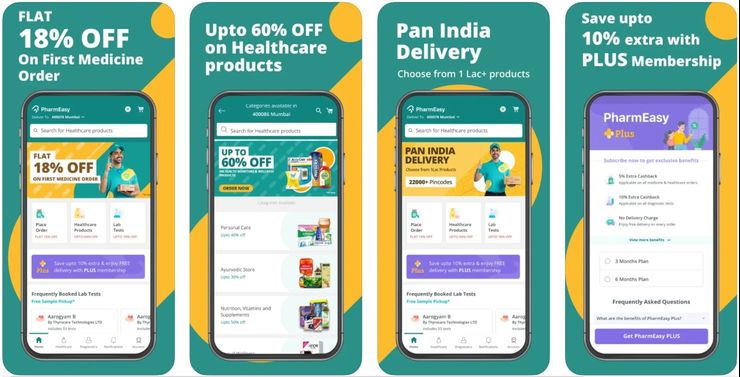
PharmEasy app. Source: Appedus
You can build a medicine delivery app for your existing pharmacy or opt for a retail model and partner with various brick and mortar pharmacies. With the latter, you receive a fee for sold items in addition to charging for deliveries. In four words, it’s an Uber for medicine.
Mental health applications
Mental health apps don't replace professional mental health care or diagnose conditions. Still, they can offer additional support between therapy sessions or provide ongoing support after a user stops attending therapy. Apps provide motivation, encouragement, and daily exercises. Good examples of apps designed to boost mental health are MoodKit, Better Stop Suicide, iBreathe, and MindShift CBT.
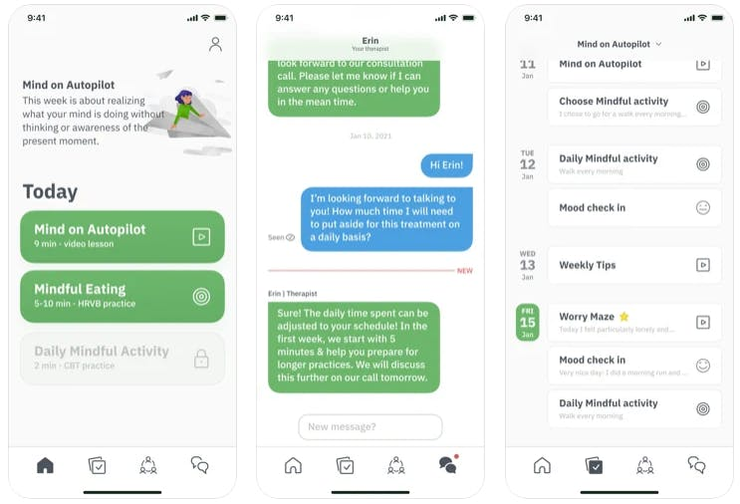
Meru Health app. Source: App Store
Since the Covid-19 pandemic forced people to seek healthcare online, mental healthcare app development has become a very profitable venture. In 2020, Meru Health, an online mental health provider, grew its customer base 10 times over and its revenue by 700%. In 2021, Meru Health secured 38 million in Series B funding, securing its reputation as a telehealth unicorn.
Priority features in healthcare application development
The cost of healthcare app development varies depending on how many features you include, and the stand-out features that determine how modern and competitive the final product is. Every app is unique, so there’s no universal list of features. But regardless of app type, there are some essentials:
Balance science and fun in mobile health app development
Health is the real deal and the accuracy of the information you provide is of vital importance. Engaging industry professionals and experts to help craft the app is essential.
If you want to make a drug search application, for example, contact a licensed pharmacist. Or, if you want to create a health measurement app focused on heart conditions, find an experienced cardiologist who is eager to participate in health app development.
Despite the seriousness of the subject matter, a healthcare app shouldn't have a complicated look and feel. It has to be engaging and fun for users. Since most medical issues and doctor’s appointments are accompanied by stress, the interface should be positive and supportive. The app’s functional capabilities should be tested by users on different devices, including those with poor connectivity, and against load to make sure patients will get what they expect in any situation.
Implement artificial intelligence (AI)
If you’re planning to build an advanced product, know that medical app development greatly benefits from AI-based solutions. All aspects of the healthcare industry are being digitised: patient records, exam results, radiology report data, and so on. By analysing and checking billions of case histories, artificial intelligence can provide insights human doctors can’t.
AI can adapt to each individual's needs by analysing their data, as well as keep up with thousands of drugs, treatments, and new studies. This is something human beings simply cannot do. For example, the symptom assessment app Ada features a smart system that learns from users’ answers. It reached over six million users and won numerous awards, showing that context-aware technologies are among the most important trends in healthcare mobile apps.
Applications that continuously collect health information and analyse it make for efficient early-stage prediction tools. Many health problems identified in the early stages are remediable, which makes quick and accurate symptom detection one of the industry’s key priorities.
Comply with data security requirements
When developing a healthcare app, you have to follow certain rules as your service is going to gather sensitive patient information. In general, these rules are similar for most countries. Still, double-checking for differences wouldn’t harm. For the US you need to study the Health Insurance Portability and Accountability Act (HIPAA). For Australia, you can find guidance on the Australian Digital Health Agency (ADHA) and the Australian Cyber Security Centre (ACSC) websites.
To comply with data security requirements, your app should adopt the latest encryption practices and conduct regular penetration testing and vulnerability assessments. An app login via social media isn't appropriate for healthcare and medical apps. The system has to provide a unique identifier with biometric data, for example. To prevent third parties from gaining access, there should also be an automatic logout feature.
Push notifications need to be designed carefully so that sensitive data doesn't appear on the screen. To protect privacy and medical data, add a secure messaging feature to your healthcare app development plan. The solution you'll need is similar to MadAppGang Strongbox, a highly secure team messenger that offers point-to-point encryption, X3DH protocol for confidential key exchange, and more.
Integrate with wearables
The opportunity to share health data from fitness trackers and health-monitoring tools with doctors seems useful in theory, but how does it work in practice? Medical professionals claim there is an information-sharing gap between self-tracking systems and actual healthcare.
Data gathered with the help of most wearables isn't enough to make a diagnosis. Besides, the devices may make errors. However, even a simple wearable can help monitor people who already have a diagnosis and need to track their heart rate or blood-oxygen levels, for example.
Medical wearable sensors offer a higher level of trust. Here are some recent solutions: Imec developed a device that measures stress levels, Valencell made a hearing aid sensor, and Proteus Discover created a patch that gathers and sends general health data.
It might be a good idea to create a wearable solution in addition to your healthcare app. Or, at least, make the application compatible with popular existing wearables.
Follow Agile software development process
Agile is a set of management practices that enables organisations to master continuous change. The lifecycle of an Agile project is composed of multiple cycles. It starts with the development phase, followed by review, feedback, and the approval/disapproval of the work item.
In comparison with Waterfall, a traditional linear and sequential approach to software development, the Agile method offers some additional benefits. For example, it allows requirement changes at any time and enables early-stage product testing. With Agile, you can improve your product from the development stage and even release the end-product faster as Agile methodologies support concurrent testing.
Hire healthcare developers with experience
The most important stage in healthcare app development is to hire professionals. The best option for entrepreneurs is to find an existing team. Doing so not only saves a great deal of time and makes it faster to launch the product, but it also saves a significant amount of money in the end. Not to mention the tons of useful information and priceless advice you can get from the experts.
With over a decade of experience building wearables and healthcare apps, the MadAppGang team has the expertise to take on any challenge. Our company uses the latest technologies, works hard, and provides smart solutions. Let us handle all the technical stuff, so you can focus on your marketing plan.
Could it be that you've already completed the first step towards successful healthcare app development and found your ideal team? Find out more about our healthcare app development services, team, and experience. Or, simply drop us a message and let's discuss your idea.
